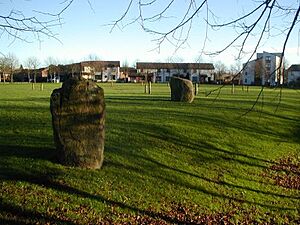Balfarg facts for kids
Balfarg is a special place in Glenrothes, Fife, Scotland. It has two main parts: an amazing ancient site from long, long ago, and a modern neighborhood where people live today. The ancient part is protected as a scheduled monument, which means it's really important and kept safe.
Discovering Balfarg Henge
The Balfarg henge is a big, circular earthwork that was built thousands of years ago. It's part of a larger area where ancient people held important ceremonies. Inside the henge, there are parts of a stone circle that have been put back together.
Archaeologists, like Roger Mercer, dug up the Balfarg henge between 1977 and 1978. They did this before new houses were built nearby. Their work showed that two large standing stones were once part of a bigger stone circle inside the henge. These two stones marked the entrance to the henge, which faced the north-west.
Inside the henge, which is about 65 meters wide, archaeologists found broken Neolithic pottery, burnt wood, and bones. These items were left there before a large timber circle was built. This wooden circle was about 25 meters wide and had 16 big wooden posts. Two extra-large posts stood at the western entrance of this circle. It's thought that the henge itself was built after these wooden structures.
Special pottery called Grooved ware was found in the holes where the wooden posts stood. This pottery dates back to around 2900 BC. Some of these ancient pots might have been used to hold a poisonous plant called henbane.
Outside and inside the main wooden circle, five more rings of narrower wooden posts were found. These might have been fences or walls.
Later on, the timber circle was replaced by two concentric stone circles, meaning one circle inside another. These stone circles also had an entrance on the west side. After this, the henge was built. Around 1900 BC, a pit was dug in the center of the stone circles. Inside it, archaeologists found the body of a young man, along with a flint knife and a handled beaker, which is a type of ancient cup.
More digging happened between 1983 and 1985 by other archaeologists. They found even older pits from the Neolithic period around the Balfarg henge. They also discovered a second henge, which surrounded an ancient wooden burial area. Another wooden structure was found nearby, partly covered by two burial mounds.
Close to Balfarg is the Balbirnie stone circle, which is also part of this amazing ancient complex. For a long time, the henge was used by local kids to play football and other games. In 1995, the local fete, or fair, moved from the henge to Gilvenbank Park nearby.
Life in Balfarg Today
Balfarg is a small area with homes and no shops or big leisure places. The Gilvenbank Hotel is in the area. In 2012, Balfarg and the nearby area called The Henge got new houses.
A small stream, called a burn, flows through Balfarg. It goes through Balbirnie Park and then joins the River Leven. There's an old farm house and its buildings from the 1600s next to the Gilvenbank Hotel. These have been turned into fancy homes.
Buses run often, about every twenty minutes, to and from the Kingdom Shopping Centre. Balfarg has several play parks, but some of them need repairs. The streets in the older parts of Balfarg are named after lochs (lakes) in Scotland, like Affric Road and Tummel Road. Children living here go to Pitcoudie Primary or St Pauls Roman Catholic Primary schools. For high school, students attend Glenwood High, Glenrothes High, or St Andrews RC in Kirkcaldy.


